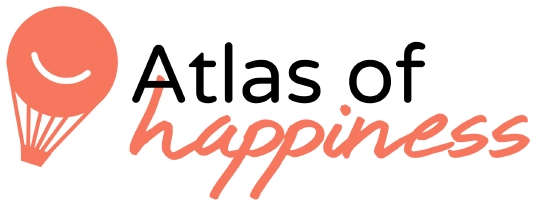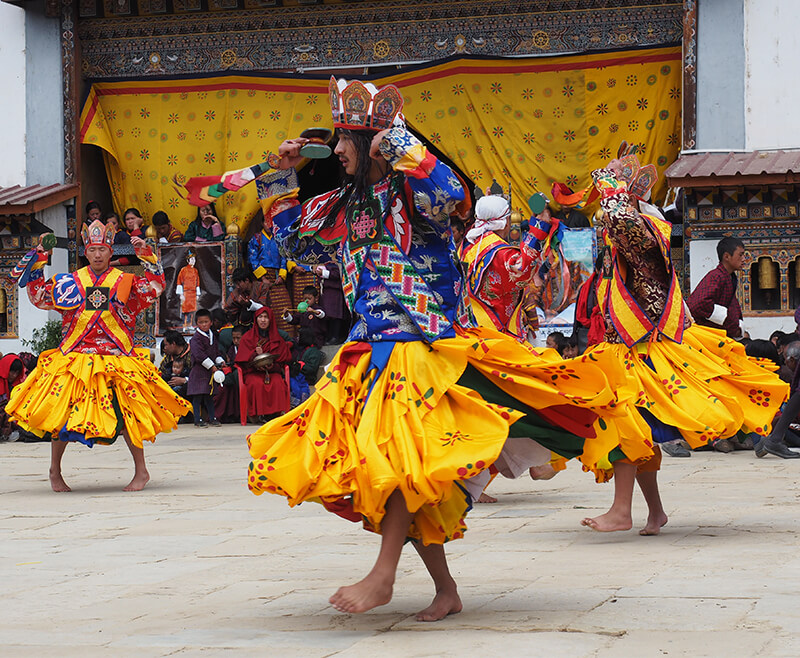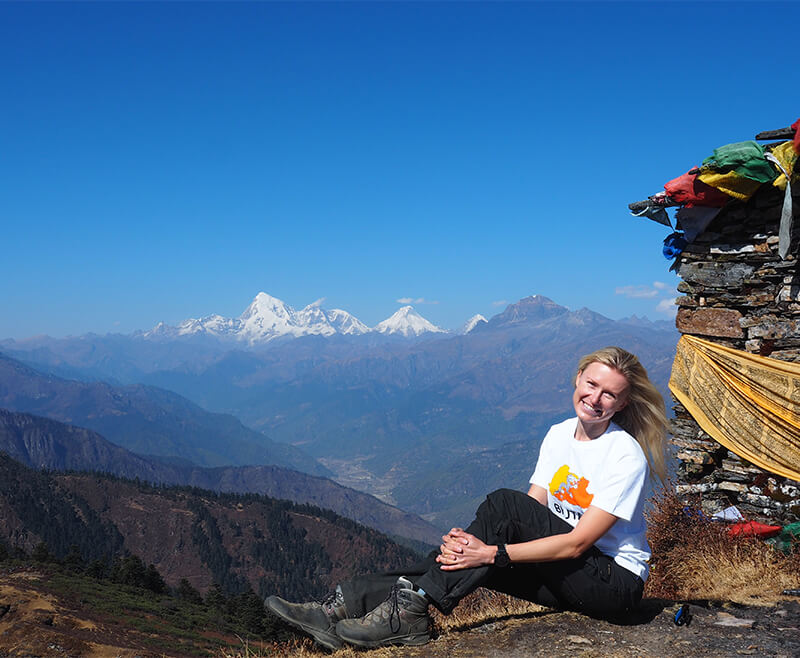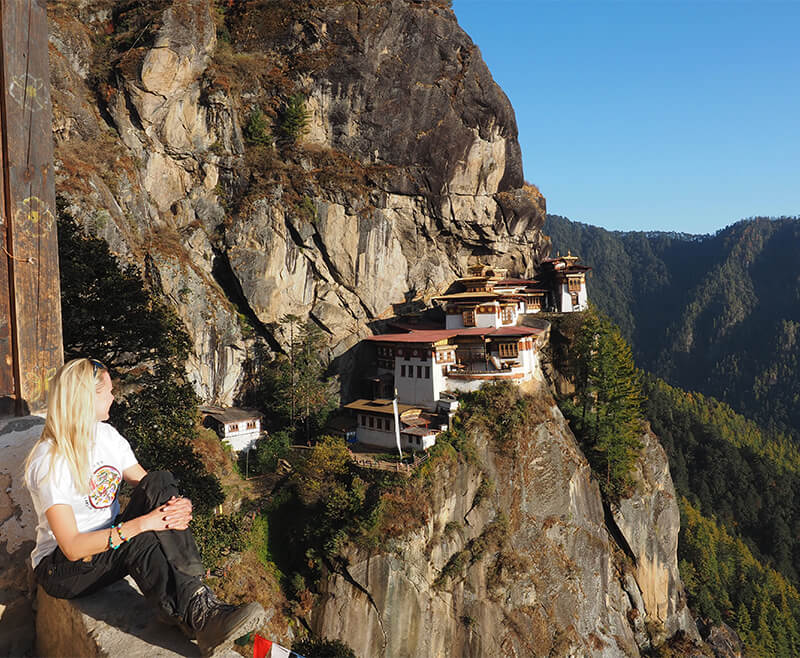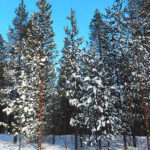Bhutan
“I left Bhutan on an almost empty plane, but with a head and heart full of good experiences and memories”.
After a breathtaking flight with dramatic views of Mt. Everest, Mt. Kanchenjunga, the Annapurna range and Mt. Gangkhar Puensum (which is the highest, unclimbed mountain in the world soaring to almost 7,570 metres), I landed in the special and magical country of Bhutan.
Paro airport is considered one of the most hazardous in the world because of the short airstrip, but I did not notice it. Bhutan is often compared to Shangri-La (a fictional paradise country) as it has all the characteristics of it. It is hard to reach; it has a mystical, fairy-tale feeling with the comforts of modern life. It’s a country where reality and fantasy live side by side, and sometimes they are indistinguishable. Adults fully believe in fairy tales and it’s contagious. I started to believe in them too, after a while. Read more about it in my blog post “Happiness lessons from Bhutan”
 Bhutan’s history and key facts: The history of this geographically isolated country is said to begin in the 7th century when the spiritual leader, Guru Rinpoche – Precious Master (by the end of the trip you will know all his 8 names by heart) :), flew from Tibet across the Himalayas on the back of a flaming tigress (his wife, actually). He arrived in Paro Valley at Tiger’s Nest (the most famous temple in Bhutan), which is also known as Paro Taktsang or the Temple of the Guru with Eight Names. At Tiger’s Nest, he conquered the local demon, Singye Samdrup, who was standing in the way of the spread of Buddhism. Although Bhutan’s early history is steeped in Buddhist folklore and mythology, Guru Rinpoche was a historical 8th century Buddhist master (also called the second Buddha) whose birth was predicted by Sakyamuni, the historical Buddha.
Bhutan’s history and key facts: The history of this geographically isolated country is said to begin in the 7th century when the spiritual leader, Guru Rinpoche – Precious Master (by the end of the trip you will know all his 8 names by heart) :), flew from Tibet across the Himalayas on the back of a flaming tigress (his wife, actually). He arrived in Paro Valley at Tiger’s Nest (the most famous temple in Bhutan), which is also known as Paro Taktsang or the Temple of the Guru with Eight Names. At Tiger’s Nest, he conquered the local demon, Singye Samdrup, who was standing in the way of the spread of Buddhism. Although Bhutan’s early history is steeped in Buddhist folklore and mythology, Guru Rinpoche was a historical 8th century Buddhist master (also called the second Buddha) whose birth was predicted by Sakyamuni, the historical Buddha.
Bhutan is a small, landlocked country with an area of roughly 38,364 square kilometres and a population of 750,000. It is bordered on the north and east by Tibet and on the south, west and east by India. The Wangchuck hereditary monarchy has wielded power since 1907. However, Bhutan became a two-party parliamentary democracy after elections in March 2008.
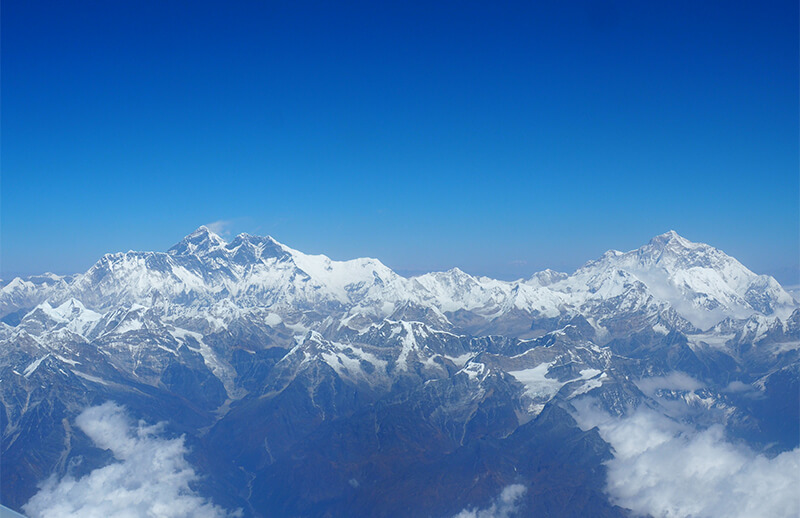

Interesting facts:
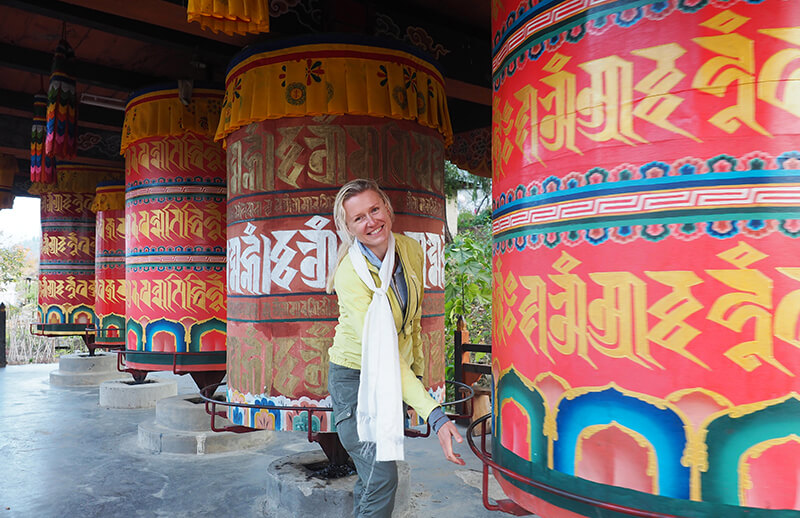

Practicalities:
Overall impressions:
Bhutanese food:
Shopping:
What to buy:

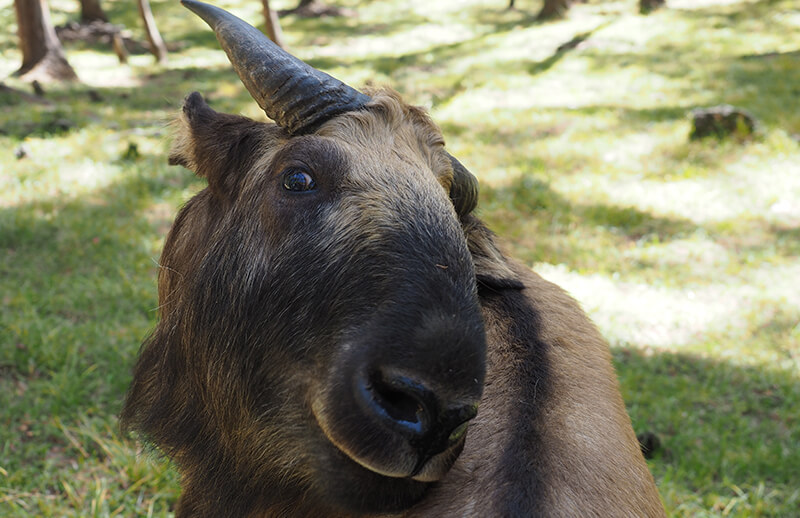
Below you can see my day-to-day diary, in case you need help with the itinerary for your visit. There would be only two things which I would do differently the next time:
– I would stay 2 nights in Thimphu and perhaps skip the night in Phobjikha valley.
– Maybe do a 3-day hike (Druk Trek).
Read more
Day 1 – Paro (temples, National Museum and Paro Dzong):
I arrived at Paro around 2pm. The flight from Kathmandu was amazing – sit on the left side, as you will see the Himalayas and Everest very well. Loved it. It’s about a one-hour flight.
My guide (Karma) and driver (Tenzin) met me at the airport. We went directly to Dumtse Lhakhang, a temple which was built in 1433 but it was undergoing renovations. I saw women working there, dancing while building a wall, a great introduction to Bhutan. The paintings on the walls were amazing – but you need to have a torch or mobile phone to see them as it’s very dark inside. You cannot take photos inside the temple.
After that, we visited the National Museum, (allow 30-40 mins for it). It has many different masks and dances, especially during the Tsechu (the biggest festival in Bhutan – all about dance of course ). From there, it’s just a 20 min walk to the Dzong (fortress) of Paro. I really liked the architecture and the colourful wooden decorations on the houses. Very different from Nepal and India.
Almost everything closes at 4pm in wintertime, from November, and 5pm in summer. That is why I asked to visit everything straight from the airport and go eating later, You can define the itinerary yourself in advance, you do not need to rely on the one proposed by your travel agent.
We had a buffet lunch at around 3pm, which was not very good, and after that I requested only to have a la carte from restaurants I found on TripAdvisor and Lonely Planet. Nevertheless, the recommendations from TripAdvisor and Lonely Planet do not work very well in Bhutan, especially in Paro (better in Thimphu). The travel agency can usually accommodate your requests but not when it’s too expensive, such as 5 star restaurants.
After lunch, we went to Kyichu Lhakhang (one of the oldest temples) which was very nice. In the evening, I walked through Paro (it’s actually a very small town) and I did some T-shirt shopping. You can pay by credit card – T-shirts are approx. 350-400Nu/rupees or USD 7. You should compare prices and bargain, but they don’t discount as much as in Nepal – only 20-30% and only if you buy several pieces. Indian sellers discount more. I was told that in the past it was not the culture of Bhutan to bargain, but now with competition from Indian sellers, they are obliged to do it. In the evening we ate at the Chef Kitchen – food was not good!
Hotel – Metta resort was out of town but OK. Spacious rooms and not a good breakfast, but it’s the same everywhere in Bhutan. In the hotel they had a traditional dance performance for a Korean group. I watched outside for an hour next to a fire. It was interesting. In the evening it gets really cold – around 5°C.
Day 2 – Paro (Tiger’s Nest, hike to Bumdrak Lhakhang and a stone bath in a farmhouse):
Hotel: Metta Resort
Today it was planned just to go to Tiger’s Nest (Taktshang) – the most popular sight in Bhutan. It’s approx. 550m climb to an altitude of over 3000m, so a lot of people spend the whole day doing just this. I wanted to go to the temples above, as described in Lonely Planet, but Karma, my guide, told that it’s too far. He definitely did not know me by then! Little did he know that I had just spent 17 days hiking in Nepal and was in great shape. I told him I would be fine to go without him but he could not allow me to do this, so he joined me.
We went directly up (without going to Tiger’s Nest). First is Zangto Pelri Lakhang – approx. 200m above Tiger’s Nest with a nice view overlooking Tiger’s Nest. It was closed, so we could only see the outside. Next is Ugyen Tshemo Lhakhang (30 min, 150m up from Pelri) with a nice view of the previous temple. After 20-30 mins more climbing we reached Yoselgang Temple with an amazing view of Paro Valley. All the temples were closed but it was actually good as otherwise we would not have been able to do what we wanted – go further to Bumdrak Lhakhang.
What people usually do over 2 days, and in a different, easier way, is to start 300m higher than we did, on the other side, and then walk more gradually up. We ascended 1774m in total. It was very difficult at the end (because of the altitude) as you reach 4125m but the views from the top were amazing and well worth it. It was a good test of my fitness level after hiking in Nepal too. I believe I passed the test!
The way down was very long. Good job that I had bandages on my knees for support and hiking poles. The icing on the cake was seeing Tiger’s Nest in the sunset light – perfect for photos. Tiger’s Nest is the most famous of Bhutan’s monasteries and also the most photogenic, hanging onto what looks from afar like a sheer vertical cliff. We took a shortcut after Pelri through a beautiful gorge and arrived at Tiger’s Nest at 4:15pm, but it had already closed being November. Luckily, Karma asked if we could get in and we saw everything almost alone. The most important thing to see there is a small chapel next to the cave where Guru Rinpoche (the most important Buddha for the Bhutanese) meditated for three months. I did not know that there are actually a lot of Buddhas, but only a few are very important. It is said that Guru Rinpoche flew there on a tigress (his wife) to subdue a local demon.
Another highlight is a talking statue. It was brought from Punakha but it was very heavy. When people tried to unload it and disassemble it, the statue spoke to them and asked not to be disassembled.
The temple burnt twice, most recently in 1998 and it was reconstructed in 2005. I felt somehow very spiritual there and lit a candle.
Summary: 33.3km hike, 1774m up, 9 hours, 4125m altitude, Bumdra hike (100,000 angels lived there). Usually a 2-day hike. Descended using the light of a mobile phone as it was dark. Everybody who heard that we did this hike (including our driver, Tenzin) were really impressed.
After this we went to Tshering Farmhouse and had a hot stone bath. It’s not something I enjoyed as I find it very unhygienic. It’s a wooden bath where hot stones are added in the water from one side (behind the wall) and you sit across in the hot water. Boring, but good for the leg muscles after such a hike. I soaked for 15 mins. I wore a swimsuit, but it is actually completely private so you don’t need to wear anything. We ate in the farmhouse on the floor. We were so hungry as I had only 3 power bars for the whole hike and I shared them with the guide. I don’t think that the hot bath and eating in a farmhouse is a must-do experience, but it’s OK. We took a packed lunch from that place for the next day – it was very good!
Day 3 – Paro (hiking on Cheli La Pass and visit of Kila Nunnery):
Hotel: Metta Resort
Paro. I stayed 3 nights in Paro – most people only stay for 2 nights, but I was happy doing this as I did two nice hikes and the weather was very good. We drove 1.5 hours to the Cheli La Pass and hiked for another 1.5 hours taking lots of photos. Then we went to the Kila Nunnery – a very nice and easy hike apart from the very steep descent when you need hiking poles. Here we had nice views of Paro, Haa Valley and the Himalayas (Jhomolhari Mountain). We had amazing weather. It took us 4 hours including 1.5 hours for photos :). The Nunnery is nothing special, but we had our packed lunch from the farmhouse which was very nice!
On the way down, we visited a Dzongdrakha Goemba Temple which again had amazing views of Paro. We arrived at 4:15pm – everything closes at 4pm – but it was nice outside. On the inside most temples look rather similar anyway. The views outside were beautiful but would have been better an hour earlier with more sun.
In the evening we ate at the Sonam Trophel Restaurant. I chose it based on TripAdvisor and Lonely Planet reviews, but it was empty and not good. I think in general all tourists just eat buffet dinners in hotels, so the restaurants in the evening are empty and only have a small selection of food. Fortunately it’s different in Thimphu as there are more tourists than in Paro.
Day 4 – Thimphu (Buddha Dordenma, Takin preserve, Textile and Painting schools, Post Office, National Library, weekend market, Changangkha Temple):
Hotel: Peaceful resort, nice location outside of town with big rooms.
I left Paro at 7:30am and went to Thimphu – only a one- hour drive which was nothing special. There are so many things to see in Thimphu so allow two nights. We saw the big Buddha Dordenma – the largest sitting Buddha in the world (51m tall)! It was very new (2012) and impressive. Inside there are 125’000 smaller statues of Buddha.
Other highlights visited: Changangkha Lhakhang temple (12th century); Takin Preserve (Takin is a really special animal: between a goat and cow – unique to Bhutan); textile museum; painting school, where you can see how Bhutanese student learn to do crafts (I bought a lot of things in the shop selling crafts done by students – big choice, good price/quality and you can bargain if you buy a lot). We saw handicrafts stalls – they are OK, but you need to have a lot of cash as they don’t take credit cards.
For lunch we ate in the Folk Museum – the best food I ate in Bhutan! The museum is also rather interesting but small. It would take you approx. 15 min to see it all! We went to the post office and I got stamps with my own photo on it. You can give any photo from your mobile phone and then you can get stamps with it – Really cool! 🙂 costs 500Nu (7USD) to send 12 international cards. So I wrote and sent 12 cards, which took me two evenings to do. We also visited the National Library and saw the biggest book in the world (but now there is another one – the Koran, which is bigger – from 2012). The weekend market with vegetables, essences, honey, etc. is not very interesting. I bought some nice smelling essence, honey, fruits, and then we ate Momos in Momo corner next to the weekend market. So tasty! I absolutely loved them! They were so much better than the ones in Nepal. I ate beef and cheese – the cheese ones were amazing!
It was a very long day but nice. At night, I stayed in Peaceful Resort, outside of town with huge rooms! In general, I loved relaxing in my hotel in the evening, having tea (all hotels had a kettle), eating some chocolate and checking the plans for the next day. It was also a time to make contact with my friends and write postcards (and of course to write this very long blogpost ).
Day 5 – Punakha (archery match, driving over Dochula Pass, temple of Divine Madman, Punakha Dzong):
Hotel: Meriphuensum Resort – bungalows. The resort was OK with nice homemade chocolate but it’s outside the city and Wi-Fi is only available in Reception. Breakfast is not very good.
In the morning we saw an interesting archery match in Thimphu. A dance is performed (they dance all the time anyway 🙂 every time someone hits a target. A 3 hour drive over the Dochula Pass (3140m) should have had nice views but it was too cloudy unfortunately (also on the way back). The place is packed with Indian tourists as they don’t have to pay USD 250 per day.
I visited a temple of the Divine Madman (Chimi Lhakhang, built in 1499) – an amazing experience. He fought the devil spirits with his penis so there are a lot of penises everywhere. It is also a fertility temple, where women who can’t conceive can come to do a three-circuit walk around the temple with the huge wooden penis. Legend has it that you will then conceive and there is a book inside of the temple with many photos of happy couples around the world who, supposedly, were able to get a baby after their visit.
You can also throw a dice and see if you are blessed. I was with the highest number possible, 13 I was very happy.
Then we visited a Nunnery where it was nice to hear nuns pray and sing. The views from there were very nice. Later we went to Punakha Dzong – a really beautiful fortress where the Bhutanese people coronate all their kings. It has a temple which only kings can enter and where the rib of the god of compassion is kept.
Next to Dzong there is a 230m hanging bridge. We ate in a very good restaurant – Phuenzhi Diner. The hotel was OK but rooms were rather small and Wi-Fi was again only in Reception. People were not so friendly there but the location was beautiful and I bought great homemade chocolate.
Day 6 – Probjikha valley (Black Crane Festival):
Phobjikha valley is known as little Switzerland (but I don’t know if I agree with that ).
Hotel: Phuntsho Yangkhil Lodge – not good! Avoid it! It’s a new hotel and they have no clue how to manage it. Rather bad food, no electricity, etc.
We wanted to leave at 7am to be in time for Black Crane festival (it takes 3 hours to get there). I saw a lot of monkeys on the way. According to the Bhutanese, seeing Langur monkeys (white bodies and dark faces) is a good sign; seeing brown monkeys is a bad sign.
The festival had a lot of people and tourists for such a small village. It was mostly children performing and was rather boring. Only the mask-dances were interesting but a bit too long. It’s interesting to see once but I’m not sure I want to return to Tsechu (annual festivals) – a lot of people and the dances are all the same. Like in the hotel first night in Paro… It’s interesting to see the local people and children, and how they eat rice and curries during the performances with their hands.
We had an OK lunch in a farmhouse with a lot of tourists and the festival finished at 14:00. We then went for a short one-hour nature walk to see the black cranes (they are very far away) and checked them through the telescope at the visitor centre. It was interesting, as they are unique. They stay in Tibet for the summer and migrate here in winter. There are approx. 600 black cranes in Bhutan and approx. 10,000 in the world. Afterwards we took a short walk from the nunnery over the valley (wooden bridge) to some villages. It was interesting to see rural Bhutanese life but it’s very cold and they have constant electricity black outs unfortunately. They put the electricity cables underground so as not to disturb the black cranes, but it’s more difficult to repair them if something happens. The hotel was new but with no electricity it was very cold and the food was bad (everything was undercooked). There were far too many tourists as well. It might be better to go back to Punakha or find a better place to stay (be prepared anyway for electricity cuts and cold temperatures).
Day 7 – Thimphu, evening in Paro (Memorial Chorten, souvenir shopping, momos in Zombola, Jungshi Handmade paper factory, dinner at Babesa Village Restaurant):
The next day we went directly to Thimphu. It takes approx. 5 hours along a very twisting road that makes you rather sick. We again saw a lot of monkeys on the way, arriving at Thimphu at around 12:30. We visited the Memorial Chorten. There were a lot of old people who spend the whole days there as they believe that walking around stupas earns you a better next life. Then we ate amazing momos in Zombola (Zombola 1): 15 pieces! (3 portions): beef and cheese – I like cheese best! They were better than the momos at Momo corner next to the weekend market (I think that was a meal I will always remember). .
Afterwards, we visited a lot of handicrafts places: Jungshi Handmade paper factory (very cool!), Nado Poizokhang Incense Factory (not interesting- only scented sticks but informative), traditional medicine museum (very small – showing some weird things like how to do bloodletting and what kind of plants are used for what… not very interesting). Got to know that this famous, very expensive fungus actually grows from a caterpillar head. I spent a lot of time in Norzin Lam Craft Stalls, bought small things in Tarayana Rural products (only cash), went to Gagyel Lhundrup Weaving Centre which was interesting but I did not buy anything as it was expensive (up to USD 600) and then spent a lot of time in a shop opposite of the Post office. It had the biggest selection of bracelets and amulets – they did two very nice bracelets just for me and a necklace with a magic dagger. In the post office I posted my 12 postcards. I bought red wine for all of us (one bottle): Vintria (red dry) – good flavour but it gives you a bad hangover the next day. We had a very nice traditional dinner at Babesa Village Restaurant. It was so cool and felt as if we were part of the family. We arrived at the hotel late at 11pm. I went to bed after midnight and had to get up at the crack of dawn at 06.30am. That morning I didn’t feel good due to the alcohol, several mosquito bites during the night, noise from planes (the hotel is close to the airport) and the stress of having to pack the many things I bought. Eventually I managed to put almost everything in my suitcase (was only 23kg), a lot in my backpack and the rest in two plastic bags with fragile souvenirs. Luckily I had no problems getting on the plane with all of this. Despite being tired, everything went smoothly. The hotel is only 10 mins from the airport and I was there two hours before the flight. I had a coffee (keep approx. 500Nu for coffee, water, etc. in the airport). The airport has Wi-fi and the flight departed 20 min ahead of schedule, so make sure you are there on time. I left Bhutan on an almost empty plane but with a head and heart full of good experiences and memories.
—
I loved my week in Bhutan! I had an amazing guide and driver and I really want to come back again to this beautiful and friendly country!
11.11.2019
